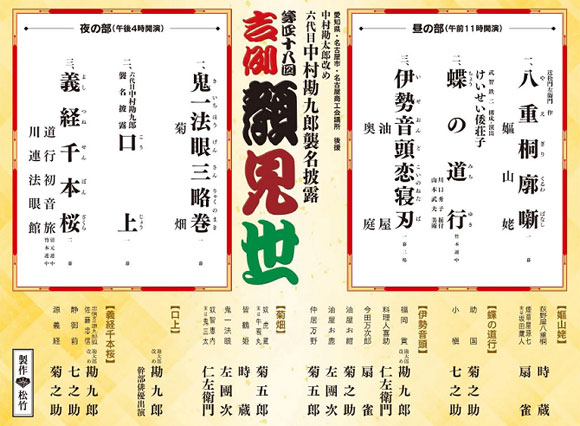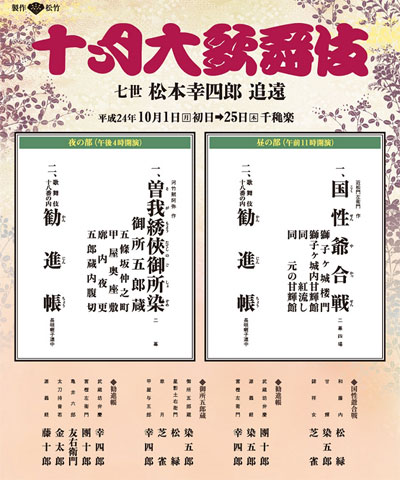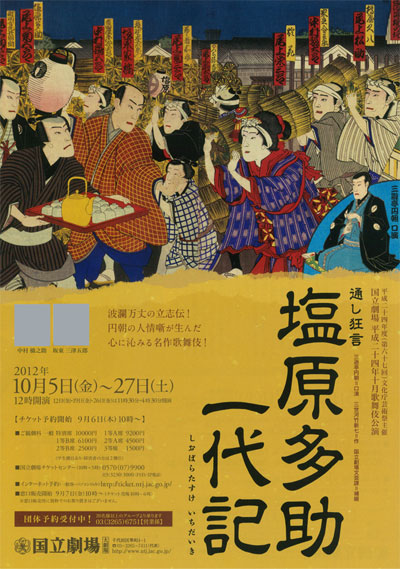| OCTOBER 2012 |
|
2 shows in Nagoya (Misonoza), 4 in T˘ky˘ (Shinbashi Enbuj˘, National Theatre, NHK Hall) and 1 in Nara (Yakushiji)!
|
| Misonoza (Nagoya) |  |
| Dates | 2 ~ 26 October 2012 (Kichirei Kaomise ďkabuki) Annual Festive Face-Showing Grand Kabuki |
| MatinÚe |
Komochi Yamanba |
| Evening |
Kiichi H˘gen Sanryaku no Maki (Kikubatake)
|
| Casting |
Onoe Kikugor˘, Kataoka Nizaemon, Nakamura Tokiz˘, Nakamura Senjaku, Ichikawa Sadanji, Nakamura Kankur˘, Onoe Kikunosuke, Nakamura Shichinosuke, Band˘ Hikosabur˘, Band˘ Yajűr˘, Kataoka Kamez˘, Ichikawa Omez˘, Band˘ Kamesabur˘, Nakamura Baishi, Band˘ Shingo, Onoe Ukon, Nakamura Mantar˘ |
| Comments |
Nakamura Kankur˘ VI celebrates his shűmei in Nagoya at the Misonoza!
|
 |
| Shinbashi Enbuj˘ (T˘ky˘) |
| Dates | 1 ~ 25 October 2012 (Jűgatsu ďkabuki) October Grand Kabuki |
| MatinÚe | |
| Evening | |
| Casting |
Ichikawa Danjűr˘, Matsumoto K˘shir˘, Sakata T˘jűr˘, Nakamura Shibajaku, ďtani Tomoemon, Onoe Sh˘roku, Kataoka Hidetar˘, Nakamura Karoku, Ichikawa Unosuke, Ichimura Kakitsu, Kataoka Ichiz˘, Ichikawa Komaz˘, Matsumoto Kingo, Band˘ Kametoshi, ďtani Hirotar˘, ďtani Hiromatsu, Matsumoto Kintar˘, Nakamura Yonekichi |
| Comments |
The Shinbashi Enbuj˘ commemorates this month late Matsumoto K˘shir˘ VII!
|
 |
| National Theatre (T˘ky˘) |
| Dates | 5 ~ 27 October 2012 |
| Program | |
| Casting |
Band˘ Mitsugor˘, Nakamura Hashinosuke, Kataoka Takatar˘, Nakamura T˘z˘, Ichikawa Danz˘, Ichimura Manjir˘, Kawarasaki Gonjűr˘, Nakamura Kinnosuke, Nakamura Matsue, Band˘ Shűch˘, Kamimura Kichiya, Nakamura Tamatar˘ |
| Comments |
Revival at the National Theatre of Kawatake Shinshichi III's drama "Shiobara Tasuke Ichidaiki", which was staged for the last time in March 1960 at the Kabukiza.
|
 |
| NHK Hall (T˘ky˘) | |
| Dates | 28 October 2012 (Koten Gein˘ Kansh˘ Kai) |
| Program | |
| Casting |
Sakata T˘jűr˘, Nakamura Senjaku, Band˘ Yajűr˘, Band˘ Takesabur˘, Nakamura Toranosuke |
| Comments |
39th edition of Koten Gein˘ Kansh˘ Kai (literally the "Classics Entertainment Appreciation Association"), a yearly performance produced by the National TV network NHK. The program includes one ky˘gen, one Kabuki play, one traditional dance and traditional music.
|
| Yakushiji (Nara) | |
| Dates | 29 ~ 30 October 2012 (Sekaisan Yakushiji H˘n˘ ďkabuki) World Heritage Yakushiji Offering Grand Kabuki |
| Program |
Goaisatsu |
| Casting | |
| Comments |
This special Kabuki performance is staged within the precincts of the famous Yakushiji temple in Nara. UNESCO listed the site as World Heritage in 1998.
|
|
|
| Contact | Main | Top | Updates | Actors | Plays | Playwrights | Programs | Links | FAQ | Glossary | Chronology | Illustrations | Prints | Characters | Derivatives | Theaters | Coming soon | News |